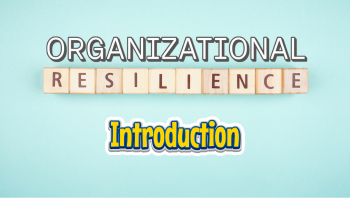Introduction into organizational resilience
What does organizational resilience really mean?
Oh, that's an interesting question! At its core, organizational resilience refers to the ability of a system—be it a company, an administration, or even an entire society—to survive profound shocks and turbulent changes unscathed and to learn from them.
Resilient organizations don't just absorb setbacks; they absorb shocks and turn them into opportunities.
It is not just a matter of passively “weathering” crises, but of actively emerging from them in a better position. Such an organization can cope with disruptions, adapt flexibly to new circumstances, and even initiate improvements, while less resilient organizations falter.
Resilient organizations have a high adaptive capacity.
What threatens an organization's resilience? The anatomy of the multi-crisis.
Although you are probably familiar with the following, it is quite important to read through the list of our current situation carefully and, above all, to understand the underlying mechanics and dynamics at work in organizations and administrations; only with a careful understanding can we then specifically influence and improve the resilience of our own organization.
Threats to organizational resilience: The anatomy of the polycrisis
The new reality: Simultaneous global crises
Today's world confronts organizations with an unprecedented density and simultaneity of crises:
- Climate change is causing increasingly frequent extreme weather events that disrupt supply chains, threaten locations, and create resource shortages.
- Pandemics such as COVID-19 are forcing entire workforces to work from home and paralyzing international transport routes.
- Geopolitical uncertainties – from the war in Ukraine and Gaza to refugee movements – are disrupting markets, driving up energy prices, and requiring sudden changes of course.
- Trade wars are creating extreme economic uncertainty.
- Added to this are technological disruptions: digital platforms, artificial intelligence, and cyber threats can challenge established business models overnight.
What is remarkable (and alarming) is that many of these crises are not isolated events, but overlap and reinforce each other!
Cascade effects in networked systems
Coupled with the extremely high global interconnectedness of our value chains, this increases vulnerability to cascade effects: If a single component fails, be it a supplier in the Far East, a single giant freighter stuck in the Suez Canal, or a cloud data center out of service, production lines around the world suddenly come to a standstill and huge traffic jams form in front of every major cargo port in the world.
The COVID-19 pandemic, among other things, has dramatically highlighted this vulnerability. Organizations that had been functioning smoothly until then were suddenly confronted with multiple “problem areas.”
The constant pressure to change is the “new normal.”
And it is a reality that can no longer be ignored. With ever shorter half-lives for certainties. Resilience is thus being put to the test: what used to be a worst-case scenario is now a regular challenge.
It is important to understand that in the past, which we now know was clearly characterized by monocrises (and not polycrises), we made our organizations increasingly complex and differentiated. And that is absolutely appropriate as long as it is a matter of solving relatively simple problems.
For this reason, modern companies and public authorities have become highly complex systems: specialized, interlinked, and often optimized to the limit.
Complexity and energy supply: a fragile balance
When complexity becomes a burden
Modern organizations are highly complex systems. However, this complexity is only sustainable as long as the necessary energy supply (resources, capital, personnel) remains stable, for example in the form of:
- constant surpluses in revenue and liquid assets
- predictable availability of raw materials and supplies
- continuous and readily available labor
- stable and “facilitating” political and institutional framework conditions
However, these urgently needed energy sources and the corresponding energy supply are declining in today's polycrisis, while the complexity of our companies and administrations remains high and is even increasing.
Joseph Tainter's theory: Why systems collapse
His collapse research shows that complex societies collapse precisely when the solutions to their problems become increasingly complex but less and less effective.
The system becomes unstable.
Applied to organizations, this means that when more and more resources are poured into managing complexity—into bureaucracy, coordination, crisis management—without achieving real progress, the system becomes unstable. Internal inertia and external turbulence combine to form a dangerous mixture: the “adaptive capacity” for successfully dealing with polycrises declines or is even lost – you may survive the first big avalanche, but what about the second and third?
Efficiency as a risk: how lean processes weaken resilience
The price of increased efficiency
Here is another major sticking point: efficiency gains have saved us for so long that they are now costing us our lives.
For a long time, efficiency was considered the top priority in business and administration. Processes were streamlined, warehouses were trimmed to “just-in-time,” buffers (“waste”) were eliminated, and organizations became increasingly focused on efficiency.
These optimizations saved costs—but often at the expense of resilience. The pandemic has shown that an overly lean organization comes at a high price in an emergency:
- Those who have no inventory cannot deliver when suppliers fail.
- Those who have planned their staffing to the limit have no reserves when many employees fall ill.
- If knowledge is not “redundant,” every early retirement means a “brain drain” for the company or administration.
- If too much profit goes to shareholders, there are no funds for necessary innovations.
Real-life examples: Hospital, Boeing & Co.
Concrete examples show how a lack of redundancy and short-term profit thinking make organizations vulnerable.
For example, in a Bavarian hospital, important deputy positions were abolished for cost reasons.
- Short-term effect: cost savings.
- Long-term effect: massive loss of knowledge and expertise in dealing with critical situations, complete failure of important positions when the person is on vacation or absent due to illness.
In the case of Boeing, a fatal cultural shift away from engineering excellence toward shareholder value was initiated: profit pressure and time pressure, as well as a newly implemented culture of profit maximization and cost reduction, compromised safety standards and led to systemic problems in management and decision-making processes and a massive loss of trust in the company. And ultimately to technical problems due to poor quality, which in the worst case led to plane crashes.
This excessive focus on (profit) optimization loses the urgently needed balance between efficiency and buffers, and resilience goes down the drain with it.
Resilience needs balance: efficiency meets buffers
Multidimensional resilience instead of individual solutions
Organizational resilience is not a contingency plan, but an interplay of strategy, structure, culture, and purpose.
And it is precisely this important balance between efficiency and buffers that we as consultants are concerned with. Our approach is certainly not to be understood as a plea for an obese organization. There is no doubt that many companies and public authorities need to optimize their processes consistently.
But much more so than in recent years, which were dominated by efficiency and optimization, it is essential in today's situation to ensure that the resilience that is vital for survival is not lost. The goal should be a consciously developed balance between efficiency and buffers, between austerity and abundance in organizations.
Hard and soft factors in balance
In order to consciously create or maintain a resilient organization, we must first understand that resilience is multidimensional. It is often equated with contingency plans, insurance, or technical backups—and robust processes and redundancies are certainly part of it.
But true organizational resilience goes much deeper: it is rooted in the carefully developed resilience dimensions of strategy, structure, culture, and purpose.
A resilient organization thus combines so-called “hard and soft” factors: on the one hand, it has a clear strategic direction, resilient systems, and flexible plans; on the other hand, it also has a culture and a clear sense of purpose that provides orientation for its members. This combination gives it vitality through adaptability.
Conclusion: Resilience is systemic – or it isn't
If you take resilience seriously, you can't stop at individual actions: it arises where purpose, strategy, structure, and culture interlock. Resilience is not a single measure, but a state of synchronized learning and adaptability, deeply embedded in the entire management system of the organization.
And it is becoming increasingly clear that a resilient and adaptable organization is not just a fluffy embellishment of a prosperous organization.
Resilience is essential for survival and a central management task.
Sources
Kyle Harper: The Fate of Rome: Climate, Disease, and the End of an Empire (2017)
Joseph Tainter: The Collapse of Complex Societies (1990)
Outlook: What you can expect in the upcoming blogs
In the following articles, we will therefore take an in-depth look at each of these dimensions of resilience – with practical approaches that are not only inspiring but also feasible.
We sincerely hope that you have enough buffer to read the other articles through to the end.


About me

All Rights Reserved
Get in touch
-
+49-(0)941 600 93 003
-
This email address is being protected from spambots. You need JavaScript enabled to view it. -
Thomas_Huber
ToChange Gmbh
-
Thomas Huber
-
Traubengasse 6
-
D-93059 Regensburg

